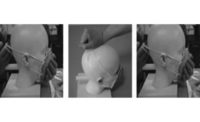In healthcare, workers wear filtering facepiece respirators as protection against inhaling infectious particles such as viruses and bacteria, but safe use does not end with putting on, or donning, the respirator. Equally important is the proper removal, or doffing, technique, which protects workers from exposure to infectious materials that may have settled on the respirator itself. Once on the hands, the viruses or bacteria pose a risk of infecting the worker if they are re-released in the air and inhaled or if the worker touches any of his or her mucous membranes.
Recommended by the Centers for Disease Control and Prevention (CDC), the proper doffing technique involves pulling the respirator straps at the back of the head. The problem, according to some reports, is that healthcare workers may not know or remember to follow these recommendations due to difficulty with locating and pulling these straps.
Addressing this issue, researchers at the National Institute for Occupational Safety and Health (NIOSH) designed and tested an intervention for NIOSH-certified N95 filtering facepiece respirators, they report in the Journal of Occupational and Environmental Hygiene. The researchers attached four red foam tabs to the straps on the respirators to act as an easy-to-find handle to grasp during removal. They then used a harmless, fluorescent substance as a tracer to track possible “contamination” from the straps to the hands and heads of 20 volunteer study participants, including 15 women and 5 men between 18 and 60 years old. Comparing the tabbed straps to the regular straps, they found that the doffing technique was comparable between both types. However, the tabbed straps resulted in significantly less spread of the fluorescent tracer substance. In addition, the modified models were easier to use than the non-tabbed models. Seven of the 20 participants found the tabbed straps easier to remove, compared with 2 of the 20 who found that doffing was easier with the non-tabbed models. Neither type of strap caused discomfort among the participants.
These findings suggest that tabs can promote ease of use and protection from contamination for workers who properly remove personal protective equipment, such as a respirator. As a next step, the investigators recommend repeating this study with a larger sample of the general population.
To provide information about the proper donning and doffing procedure for personal protective equipment, the CDC created the downloadable posters below, which also are available on the CDC website.


